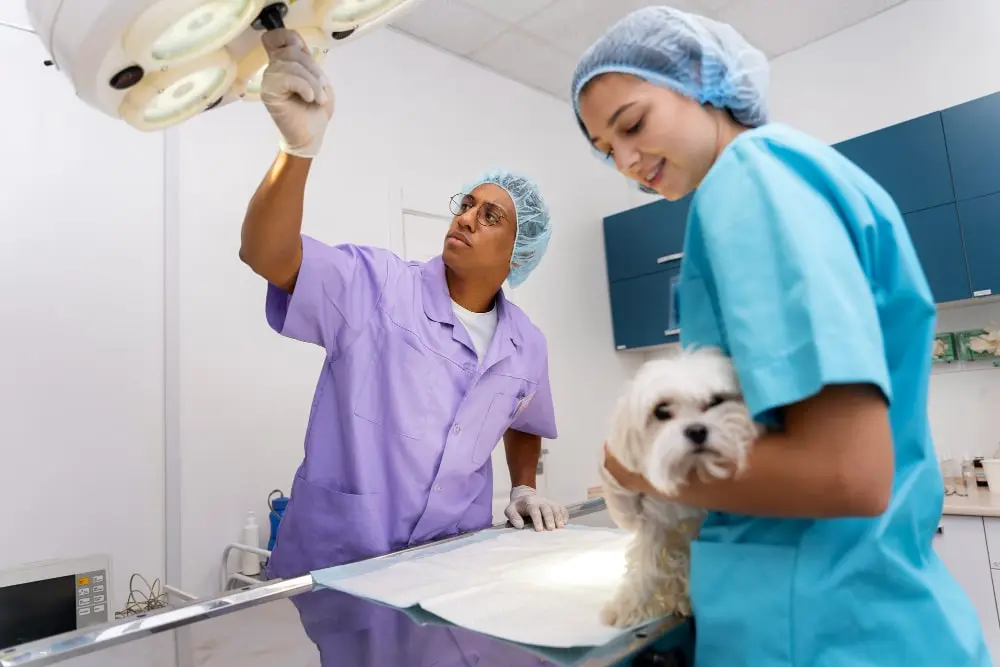We all want our pets to lead long, happy and healthy lives. Sometimes, that means making some tough decisions, such as neutering. What are some signs your dog needs to be neutered and how much do you know about it? If this seems interesting, here is everything you need to know and signs that it may be time to consider it.
What Is Neutering, and Why Is It Done?
Neutering, also called castration for male dogs, is a surgical procedure that removes the testicles. Why go through this? Well, it’s not just about preventing your pup from becoming a dad. Neutering can help reduce unwanted behaviors, improve health outcomes and contribute to being a responsible pet parent. It is done to:
- Help with behavior control – behavior such as aggressive tendencies or marking every vertical surface are driven by testosterone.
- Prevent certain health issues – neutering reduces the risks of testicular cancer and prostate-related problems.
- Limit overpopulation – shelters are full of dogs just waiting for homes and neutering prevents contributing to this crisis.
Signs Your Dog Needs to be Neutered
Your dog can’t tell you directly what they need, but their behavior carries important clues. Some things they do might appear harmless or quirky. In excess, they could point to underlying issues that neutering, as well as proper training and care than resolve. Take note of:
1. Excessive Urine Marking
It’s not unusual for dogs to mark their territory. When the habit becomes excessive, it tends to be disruptive and unhygienic in the home. For male dogs especially, this behavior may stem from more than just hormonal urges. Marking can also become a learned behavior over time or signal anxiety in some dogs. Reinforcing house training should put an end to this, however, if you have tried it unsuccessfully, neutering could be the solution. Neutering reduces the hormonal drive behind marking.
2. Persistent Mounting
Mounting isn’t always about reproduction or sexuality. Dogs might mount as a way to assert dominance, due to overstimulation, or even out of boredom. If your dog mounts persistently and in ways that cause discomfort to you, your guests, or other dogs, it’s a sign they may need intervention. It might be worse if the mounting is excessive and you are wondering is my dog sexually attracted to human.
Neutering can certainly decrease hormone-driven mounting. Still, pet owners should also look at broader solutions. A good option would be structured playtime, mental stimulation through interactive toys and training sessions that reinforce calm behavior can all help redirect their focus. If the issue escalates, consulting a professional dog trainer or behaviorist can provide tailored strategies.
3. Unprovoked or Escalating Aggression
Aggression in dogs can be complex, especially when it occurs without an obvious trigger. While hormones, particularly testosterone contribute to heightened aggression in unneutered males, it’s not the only factor. Fear, pain, past trauma, or poor socialization are also common causes of aggressive behavior.
Neutering can be part of the solution, however, don’t rush. If your dog displays signs of aggression, first consult your veterinarian to rule out any underlying health issues. Then, consider working with a professional behaviorist to address triggers, teach alternative responses, and improve your dog’s social skills. Neutering works best when paired with consistent behavior management techniques.
4. Frequent Escaping or Roaming
Does your dog seem like an escape artist, seizing every chance to dart out the door or jump over the fence? This wandering instinct is particularly strong in unneutered males, especially if they catch the scent of a nearby female in heat. It might be their cry for mating, however, it also puts your dog at risk of accidents, getting lost, or encountering wildlife.
Neutering lowers the roaming instinct driven by the need to find a mate. Other measures such as containment and engagement are just as important. Ensure your yard is secure and free of potential escape routes.
Keep your dog engaged with regular walks, exercise routines, or outings to places where they can safely explore. Remember, a dog that feels mentally and physically fulfilled will be less inclined to wander in the first place.
What Happens If Male Dogs Don’t Get Neutered?
When deciding whether or not to neuter a male dog, it’s essential to fully understand the potential risks and consequences. We understand the hesitance involved with an elective surgery. If left undone when needed, it could lead to health and societal challenges that may affect your pup and your household. Unneutered male dogs might suffer:
Health Challenges
Higher Risk of Testicular Cancer
Testicular cancer is a common health issue for intact male dogs. Without neutering, the possibility of developing this cancer remains throughout their lifetime. While it may be treatable if caught early, the cost of veterinary care and the anxiety it brings can take a toll. Neutering eliminates this risk entirely.
Prostate Problems
Intact males are more susceptible to prostate issues, including prostatitis (infection or inflammation of the prostate) and benign prostatic hyperplasia (BPH). These conditions can cause pain, discomfort while urinating and difficulties with bowel movements. They sometimes require medication, surgery or other intensive care to manage.
Undetected Testicular Diseases
An overlooked issue is the potential for cryptorchidism, a condition where one or both testicles fail to descend. This condition puts the dog at an even higher risk of testicular cancer as well as other complications. In most cases, it goes unnoticed until after the condition is advanced.
Behavioral Challenges
The impact of not neutering goes beyond health. Behavioral tendencies driven by testosterone can create frustration for both the dog and the owner:
Aggression and Dominance Issues
Intact males are more likely to exhibit aggressive tendencies, particularly toward other male dogs. This can lead to fights, injuries, and stress. While not all unneutered dogs are aggressive, the hormone-driven behavior is undeniably higher compared to neutered dogs.
Territorial Marking
Unneutered male dogs often feel the urge to assert their dominance by marking their territory with urine. The marking may go beyond the couches, walls and perimeter fences. Your visitors might fall victim to this.
Restlessness Around Females in Heat
One of the most common frustrations for dog owners is managing an unneutered male’s intense and sometimes uncontrollable reactions to females in heat. They may whine, pace, or become overly agitated. Some dogs will even go to extreme lengths, such as trying to escape the home, digging under fences, or scaling barriers in a desperate effort to reach a nearby female.
Societal Consequences
The decision to not neuter your dog doesn’t just impact your household; it can have broader consequences for the canine community:
Contributing to Overpopulation
A single unneutered male dog can sire dozens, if not hundreds, of puppies over its lifetime. Millions of pets end up in shelters each year. Many face euthanasia due to overcrowding. Therefore, responsible pet ownership important and neutering helps reduce the number of litters born into an uncertain future.
Strain on Animal Shelters and Rescues
Shelters work tirelessly to care for abandoned and stray dogs, but their resources are finite. Every unplanned litter adds to the burden, limiting shelters’ ability to help other animals in need.
The Health Benefits of Neutering
On the flip side, the benefits of neutering your male dog can be a game-changer for their health and wellbeing. Here’s how:
1. Protection Against Cancer
Neutering eliminates the risk of testicular cancer entirely and significantly reduces the chances of common prostate issues. By removing the testicles, hormonal imbalance-related growths, infections, and swelling are far less likely to occur.
2. Reduced Urge to Roam and Associated Risks
Male dogs with intact hormones have a natural drive to search for mates, which can lead to dangerous roaming behavior. They may dart through busy streets, get into fights with other animals, or become lost entirely. Neutering significantly lowers this instinct, helping to keep your dog safe at home where they belong.
4. Longevity and Improved Quality of Life
Statistically, neutered dogs tend to live longer than unneutered ones. Neutered males enjoy a 13.8% longer lifespan than unneutered ones. The longer lifespan is due to the reduced risks of cancer, roaming-related injuries, and other health complications associated with high testosterone levels. A longer life allows more shared memories and adventures with your pup. You can read about the average life cycle of a dog as well.
Common Myths and Misconceptions around Neutering
Pet owners often have concerns based on myths they’ve heard, but it’s important to separate fact from fiction. Here’s a closer look at common fears:
Myth: Neutering will change my dog’s personality
Neutering won’t take away your dog’s quirky, lovable traits. It simply reduces hormone-related behaviors like aggression or marking.
Myth: It’s unnatural or cruel
The procedure is a routine part of veterinary care and doesn’t harm your dog’s long-term well-being. Your dog will recover quickly and return to their usual playful self.
Myth: My dog will become lazy or overweight
Weight gain is more related to diet and activity level than neutering. Proper exercise and portion control can keep your pup in great shape.
What is The Right Age for Neutering?
When’s the best time to neuter your dog? It depends on a few factors like breed, size, and overall health: For small breeds like Chihuahuas, they are ready for neutering as early as 4 to 6 months. Larger breeds like Labradors and German Shepherds are ready at between 12 and 18 months. that is when their bones and joints are well developed.
NOTE: Breed and size are a general limit. Individual variation matters. Consult your vet, who will consider your dog’s growth, health and development before recommending the right age for neutering.
The Recovery Process
Once your dog has been neutered, completing the recovery process carefully is essential. Here’s how to ensure everything goes smoothly:
Immediate Aftercare
- Keep Things Calm: Your dog needs rest to recover. Limit activities like running, jumping, or playing for at least 7–10 days.
- Monitor the Surgical Site: Watch for swelling or unusual redness. If you notice any discharge or excessive licking, contact your vet.
Do’s and Don’ts of Recovery
- Do ensure your dog wears an Elizabethan collar (e-collar) to prevent irritation of the stitches.
- Don’t bathe your dog until your vet gives the green light. It’s crucial to keep the incision dry.
Look for Complications
Keep an eye out for signs like refusal to eat, lethargy, or any signs of pain. If anything feels off, consult your veterinarian immediately.
Are You Ready?
Choosing to neuter your dog is a major, possible overwhelming but a caring decision. If it seems like you have noticed signs your dog needs to be neutered, first consult your vet. You understand the health benefits, myths and how to care for them post-surgery. Hopefully, it will make the process more bearable for both of you.





